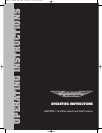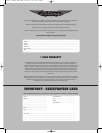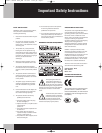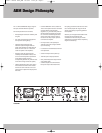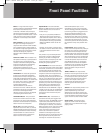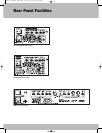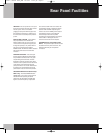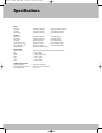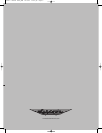
Front Panel Facilities
INPUTS - A single instrument input is
provided, linked to a PASSIVE/ACTIVE selector
switch (switch out=PASSIVE, switch
in=ACTIVE). In PASSIVE mode, the input is
high sensitivity and also high impedance to
suit the output from PASSIVE basses. In active
mode, the input is low sensitivity and lower
impedance to suit the output from ACTIVE
basses.
INPUT CONTROL - The INPUT control sets
the signal level through the preamp in
conjunction with the INPUT LEVEL VU Meter.
This is adjusted to give a reading of 0VU on
the meter for average playing dynamics with
occasional peaks into the red region. Please
note that this setting may require re-
adjustment after modification of the EQ
controls.
PUSH FLAT / SHAPE - With this button in its
OUT position a fixed E.Q. is superimposed on
the preamp to give a bright but punchy
character to the sound. Pushing this button
IN returns the preamp to a Flat frequency
response. This function may also be
controlled from a footswitch. For the
footswitch to operate, this button must be in
its OUT position.
VALVE DRIVE - This routes the signal either
through a clean Solid State amplification
section (control on zero) or through a Dual
Triode Tube amplification/overdrive section
to add either tonal character, i.e. warmth with
the control set at 9 o’clock, a slight edge in
the sound at 12 o’clock, through to an
increasing degree of Tube
distortion/overdrive as the control is
advanced to maximum. A Mix of these two
amplification sections can be achieved with
this control. N.B. The degree of Tube
distortion with this control will also depend
on the setting of the INPUT control.
VALVE DRIVE IN/OUT - This push button
switches the valve drive section IN or OUT.
This function may also be controlled from a
footswitch. For the footswitch to operate this
button must be in its OUT position.
E.Q. IN / OUT - This button switches the
Equalisation section IN or OUT, i.e., the Bass,
Middle and Treble controls and the two sets
of sliders placed between these. This facility
is footswitchable via a socket on the rear
panel. For the footswitch to operate this
button must be in its out position.
EQUALISATION - This consists of BASS,
MIDDLE and TREBLE controls with two sliders
placed in between. This can be used in a
number of ways:
• Firstly as a very simple Bass, Middle and
Treble tone control section as found on
older traditional amplifiers. This is done by
leaving the two sets of sliders set in their
centre positions and using only the BASS,
MIDDLE and TREBLE controls to alter the
overall tone.
• Secondly, if more control is required, then
the sliders can also be used to tailor the E.Q.
in the regions between the main tone
controls.
This provides a very versatile Equalisation
section that is simple to understand and
operate, yet provides a wide degree of
variation. It retains the simplicity of a three-
control tone section but provides the
flexibility of a graphic equaliser.
SUB HARMONICS - This section consists of
an IN / OUT switch and a LEVEL control. When
switched IN, Sub Harmonics an octave below
the notes being played are produced. The
level of these Sub Harmonics relative to the
straight bass sound can be adjusted using
the LEVEL control. This is very effective in
thickening the sound and you will find in use
that only a small degree of this lower octave
is required to really fill out the sound and
provide a character to the sound that is not
possible by any other means. The degree of
Sub Harmonics is also dependant on the
setting of the BASS control. This facility is
footswitchable on the ABM/RPM-1 range via
a socket on the rear panel. For the footswitch
to operate the Sub Harmonics must first be
switched into circuit with the front panel
push button.
DIRECT INJECT (D.I.) - A balanced D.I. is
provided on the front panel rugged metal
latching XLR socket. The ABM/RPM-1 features
a push button placed below the XLR that
allows the user to choose either a Pre E.Q. /
Pre Sub signal or a Post E.Q. / Post Sub and
Effects signal (the Pre E.Q. signal also includes
the Shape facility, if this is switched into
circuit). The output signal from this XLR
socket is set to a level and impedance
suitable for connecting directly into the
Microphone input of a mixing desk for either
Direct Injection into the PA system or for
recording. This must ONLY be used into a
Balanced Microphone input. It is not
intended for any other type of connection.
This has a floating ground that is referenced
to the mixing console it is plugged into and
should not need ground lifting. It is also
unaffected by Phantom Powering on the
Microphone input. Make sure your XLR plug
does not have the shell of the plug internally
connected to the ground signal or this will
connect the system to the chassis ground of
the amplifier and may cause problems with
hum.
PUSH TO MUTE - When pushed IN this
button mutes the output from the preamp to
the power amp, mutes the output from the
D.I. socket and mutes the output from the
Sub Out socket as well. This leaves the output
from the TUNER / LINE socket still available to
allow muted tuning. An LED is provided next
to this switch to indicate when the amplifier
is muted. This operates only from the front
panel MUTE push switch, i.e. pressing this
button mutes all sound from the amplifier
and allows a tuner connected to the TUNER /
LINE socket to operate for silent tuning.
Release the button and you are back in
action again.
TUNER / LINE OUT - This output socket
provides a line level signal that can be used
either for a permanent connection to a tuner
or a line output to slave up to other power
amplifiers. Please note that if this socket is
used as a slave output to other power
amplifiers that the MUTE button will not
mute the signal to the external power
amplifiers.
SUB OUT - This output socket provides a Low
Pass filtered output for connection to a
power amplifier driving a sub unit for
additional extra-low bottom end. This may
also be used to drive other power amplifiers
to provide additional low bottom end to the
system. The Low Pass filter is fixed at 160Hz.
OUTPUT LEVEL - The OUTPUT control
adjusts the overall level of the amplifier.
Adjust this for your preferred overall stage
playing volume.
#17669 - Manual 2005_ABM 18/4/05 12:21 pm Page 6



